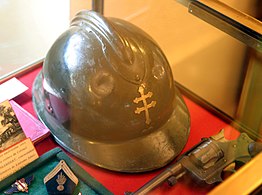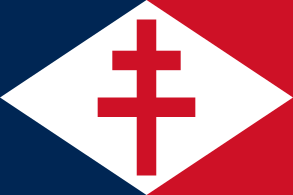Lorraine cross
Lothringerkreuz or Lothringer Kreuz ( French : Croix de Lorraine or Croix d'Anjou ) is the name for a cross with two crossbars of equal length, with the lower crossbar usually as far away from the lower end of the longitudinal bar as the upper crossbar from the upper one. This form had been common in Poland , Lithuania , Slovakia and Lorraine since the Middle Ages .
Alsace-Lorraine had a patriarchal cross in its flag since 1912 , as did the French resistance ( Free French Armed Forces ) from 1940 to 1944 . But this was also called the Lorraine Cross. This resulted in a conceptual mixing of the two crosses.
history
Slovakia, Poland and Lithuania
A cross with two bars of equal length has been known since the early Middle Ages, among other things as a rune . By the 14th century at the latest, a cross with two crossbars of equal length was the emblem of the Jagiellonian dynasty , which ruled large parts of Eastern and Southeastern Europe.
Princes of Anjou
Counts and Dukes of Anjou (and Dukes of Lorraine afterwards) use Lorraine crosses as symbols of the relics of the Holy Cross of Angers .
Cross on the tower of Angers Cathedral ( Anjou )
Stanislaus I. Leszczyński's coat of arms as Duke of Lorraine
Alsace-Lorraine 1912 to 1918

Since June 25, 1912, the Reichsland Alsace-Lorraine in the German Empire had a cross in its flag. The shape of this cross was a patriarchal cross . From November 11 to 21, 1918, the Soviet Republic of Alsace-Lorraine carried the same cross in its flag.
1940–1944 Free French forces
During the Second World War , after the capitulation of France and the installation of the Vichy government under Philippe Pétain in the summer of 1940, the French government in exile in London chose the Lorraine cross with modified crossbars as its symbol. Georges Thierry d'Argenlieu proposed the use of the Lorraine cross on July 1, 1940 at Charles de Gaulle in order to have a symbol to oppose the swastika . Since then, the Free French Armed Forces have been fighting under this symbol. It can also be seen on three French orders or medals of merit from this era: the Ordre de la Liberation , the Médaille de la Résistance and the Médaille commémorative des services volontaires dans la France Libre . On the collar tab of his uniform, however, de Gaulle wore a different variant of the cross, which could be described as the "patriarchal clover-leaf cross" - it was a cross with clover-shaped arms, as can be seen in old newsreels .
The Lorraine Cross is a symbol of the French Free Forces until the 21st century. As a sign of the government in exile and in memory of the successful invasion of the Allied forces in Normandy in 1944 (" Operation Overlord "), there are some Lorraine crosses on the landing beaches there. The monument to Charles de Gaulle in Colombey-les-Deux-Églises shows a Lorraine cross. The last two ships of the sea forces of Free France (FNFL) who are still on active duty today's French Navy - the two sail training ships Belle Poule and Etoile - which FNFL- set in the 21st century traditional Gösch with the Cross of Lorraine.
1940–1944 Gösch of the Free French Maritime Forces (FNFL)
Cross of Lorraine on a Tankette type Renault UE Chenillette
Médaille de la Résistance with rose window
Etoile and Belle Poule with the naval jack of FNFL
De Gaulle memorial in Colombey , 1972
Others
- A related symbol is used by the American Lung Association .
Characters
|
☨
|
In Unicode "in the block Various symbols " as U + 2628 cross of lorraine one character whose code shown in the tables glyph but no clear demarcation to the patriarchal cross shows.
A symbol that comes close to the design principle of the Lorraine cross is the two-bar cross (U + 2021 double dagger in the Unicode block " General Punctuation "), which, however, has a design unsuitable for cross symbols in many fonts (in particular, the representation of longitudinal and cross bars is common not rectangular).
Another such character is U + 29E7 thermodynamic (“vertical bar crossed by two horizontals”) in the Unicode block “ Various mathematical symbols-B ”.
literature
- Gert Oswald : Lexicon of Heraldry. Bibliographisches Institut, Mannheim et al. 1984, ISBN 3-411-02149-7 .
Web links
- Mark R. Hatlie: War Memorials at Church in Tuebingen / Kilchberg , on sites-of-memory.de . ( The original Lorraine cross was used on the memorial. )
Individual evidence
- ↑ Pierre Quatrepoint: Georges Thierry d'Argenlieu (7 août 1889–7 September 1964) . On: guerre-mondiale.org .
- ↑ Code Tables - Miscellaneous Symbols. (PDF; 368 kB) Unicode Consortium, accessed on August 3, 2012 .
- ↑ Code Tables - Miscellaneous Mathematical Symbols B. (PDF; 211 kB) Unicode Consortium, accessed on September 12, 2012 : " vertical bar crossed by two horizontals "



















